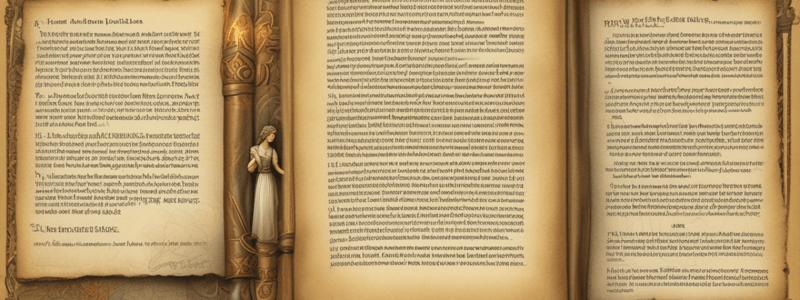Podcast
Questions and Answers
What is the primary purpose of expository text?
What is the primary purpose of expository text?
- To persuade the reader
- To entertain the reader
- To tell a story
- To explain, describe, or give information on a subject or topic (correct)
Which of the following is NOT a type of medium that typically contains expository text?
Which of the following is NOT a type of medium that typically contains expository text?
- Newspapers
- Encyclopedias
- Novels (correct)
- Textbooks
What is the main benefit of using a table of contents?
What is the main benefit of using a table of contents?
- It provides a summary of the text
- It provides a list of authors
- It shows how the text is arranged and includes page numbers (correct)
- It gives a glossary of terms
How can a table of contents be used in a research project?
How can a table of contents be used in a research project?
What might a more detailed table of contents include?
What might a more detailed table of contents include?
What is the main purpose of headers and subtitles in an expository text?
What is the main purpose of headers and subtitles in an expository text?
What is the function of a caption in an expository text?
What is the function of a caption in an expository text?
What is the main difference between footnotes and endnotes?
What is the main difference between footnotes and endnotes?
What is the purpose of the glossary in an expository text?
What is the purpose of the glossary in an expository text?
What is the main purpose of the index in an expository text?
What is the main purpose of the index in an expository text?
What is the primary goal of reading expository texts?
What is the primary goal of reading expository texts?
What is the purpose of organizational features in expository texts?
What is the purpose of organizational features in expository texts?
Where can you typically find expository texts?
Where can you typically find expository texts?
How can a table of contents help you in a research project?
How can a table of contents help you in a research project?
What does a table of contents typically include?
What does a table of contents typically include?
What is the primary function of headers and subtitles in an expository text?
What is the primary function of headers and subtitles in an expository text?
What is the purpose of a caption in an expository text?
What is the purpose of a caption in an expository text?
Where do footnotes typically appear in an expository text?
Where do footnotes typically appear in an expository text?
What is the purpose of the glossary in an expository text?
What is the purpose of the glossary in an expository text?
What is the main benefit of using the index in an expository text?
What is the main benefit of using the index in an expository text?
Flashcards are hidden until you start studying
Study Notes
Expository Texts
- Expository texts aim to explain, describe, or provide information on a subject or topic.
- Examples of expository texts include newspapers, textbooks, magazines, and encyclopedias, both in physical and online forms.
Organizational Features of Expository Texts
- Table of Contents:
- A list of chapters or sections in the text, provided in order of appearance.
- Includes page numbers for each chapter or section.
- May show units each chapter is separated into or the location of other content like pictures and graphs.
Using Organizational Features
- Table of Contents:
- Use to find specific information by locating the relevant chapter or section.
- Example: finding information on flower reproduction in a science textbook.
Headers, Subtitles, and Captions
- Headers and Subtitles:
- Smaller titles that occur beneath the titles of larger chapters or sections.
- Give an idea of what the smaller section is about.
- Example: finding a section on flower reproduction within a chapter on plant biology.
- Captions:
- Titles or brief explanations occurring beneath pictures, images, graphs, or other illustrations.
- Explain the content of the image or illustration.
- Example: a caption explaining the parts of a flower involved in reproduction.
Footnotes and Endnotes
- Footnotes:
- Appear at the bottom of the page and provide short clarifications for specific terms or phrases.
- Each footnote corresponds to a part of the article and is labeled with a number or symbol.
- Example: a footnote explaining the term "agent of cross-pollination".
- Endnotes:
- Similar to footnotes, but occur at the end of the chapter or section.
- May include sources for the article or other important clarifications.
Glossary and Index
- Glossary:
- A short dictionary including important terms from the text.
- Vocabulary words are listed in alphabetical order for easy reference.
- Example: using the glossary to look up unfamiliar terms like "pistil" and "stamen".
- Index:
- Lists important names, terms, subjects, topics, pictures, and more in alphabetical order.
- Shows the pages where the information can be found.
- Example: using the index to find specific concepts or pictures in the text.
Studying That Suits You
Use AI to generate personalized quizzes and flashcards to suit your learning preferences.




